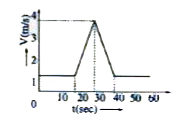Generally, we consider that during slowing of a moving automobile, its retardation is constant, but in practice this is seldom the case. Under many circumstances, especially at high speed, we usually apply the brakes slowly at first and then more strongly as the car slows. The braking force therefore depends on the time during the interval over which the car is slowing and acceleration changes with time.
ax(t)=vA−vxdt=Fx(t)m
∫vxv0xdVx=∫10Fx(t)mdt
∴Vx=V0x+1m∫10Fx(t)dt
x(t)=x0+∫10Vx(t)dt
An example for the same is discussed here.
A car of mass m = 1000 kg is moving with 25 m/s. The driver begins to apply the brakes so that the magnitude of the braking force increases linearly with time at a rate of 2000 N/s.
Read the above passage carefully and answer the following questions.
How much time passes before the car comes to rest?
5 sec
4 sec
8 sec
6.5 sec
The correct Answer is:A
To solve the problem of how much time passes before the car comes to rest, we can follow these steps:
Step 1: Understand the given data
- Mass of the car, m=1000kg
- Initial velocity of the car, v0=25m/s
- Rate of increase of braking force, dFdt=2000N/s
Step 2: Calculate the initial momentum
The initial momentum p0 of the car can be calculated using the formula:
p0=m⋅v0=1000kg⋅25m/s=25000kg m/s
Step 3: Set up the impulse-momentum theorem
According to the impulse-momentum theorem:
Impulse=Δp=pf−p0
where pf is the final momentum (which is 0 when the car comes to rest). Therefore:
Δp=0−25000=−25000kg m/s
Step 4: Express the impulse in terms of force
The impulse can also be expressed as:
Impulse=∫t0F(t)dt
Since the braking force F(t) increases linearly with time, we can express it as:
F(t)=2000tN
Thus, the impulse becomes:
∫t0F(t)dt=∫t02000tdt=2000∫t0tdt=2000(t22)t0=1000t2
Step 5: Set up the equation
Now we can set the impulse equal to the change in momentum:
1000t2=25000
Step 6: Solve for time t
Dividing both sides by 1000:
t2=25
Taking the square root:
t=5s
Conclusion
The time that passes before the car comes to rest is t=5 seconds.
---
- Mass of the car, m=1000kg
- Initial velocity of the car, v0=25m/s
- Rate of increase of braking force, dFdt=2000N/s
The initial momentum p0 of the car can be calculated using the formula:
p0=m⋅v0=1000kg⋅25m/s=25000kg m/s
According to the impulse-momentum theorem:
Impulse=Δp=pf−p0
where pf is the final momentum (which is 0 when the car comes to rest). Therefore:
Δp=0−25000=−25000kg m/s
The impulse can also be expressed as:
Impulse=∫t0F(t)dt
Since the braking force F(t) increases linearly with time, we can express it as:
F(t)=2000tN
Thus, the impulse becomes:
∫t0F(t)dt=∫t02000tdt=2000∫t0tdt=2000(t22)t0=1000t2
Now we can set the impulse equal to the change in momentum:
1000t2=25000
Dividing both sides by 1000:
t2=25
Taking the square root:
t=5s
The time that passes before the car comes to rest is t=5 seconds.
Similar Questions
Generally, we consider that during slowing of a moving automobile, its retardation is constant, but in practice this is seldom the case. Under many circumstances, especially at high speed, we usually apply the brakes slowly at first and then more strongly as the car slows. The braking force therefore depends on the time during the interval over which the car is slowing and acceleration changes with time.
ax(t)=vA−vxdt=Fx(t)m
∫vxv0xdVx=∫10Fx(t)mdt
∴Vx=V0x+1m∫10Fx(t)dt
x(t)=x0+∫10Vx(t)dt
An example for the same is discussed here.
A car of mass m = 1000 kg is moving with 25 m/s. The driver begins to apply the brakes so that the magnitude of the braking force increases linearly with time at a rate of 2000 N/s.
Read the above passage carefully and answer the following questions.
Find the velocity of the car at t = 10 sec.
View SolutionA car of mass 480 kg moving at a speed of 54 km per hour is stopped in 10 s. Calculate the force applied by the brakes.
View SolutionVelocity-time (v-t) graph for a moving object is shown in the figure. Total displacement of the object during the time interval when there is non-zero acceleration and retardation is

View SolutionVelocity -time (v-t) graph for a moving object is shown in the figure .Total displacement of the object during the time interval when there is non-zero acceleration and reatardation is

View SolutionA car having a mass of 1000 kg is moving at a seed of 30 metres/sec. Brakes are applied to bring the car to rest if the frictional force between the tyres and the road surface is 5000 newtons,the car will come to reast in
View SolutionA car moving with a speed of 40km/h can be stopped by applying the brakes after at least 2 m. If the same car is moving with a speed of 80km/h, what is the minimum stopping distance?
View SolutionA car moving with a speed of 40km/h can be stopped by applying the brakes after at least 2 m. If the same car is moving with a speed of 80km/h, what is the minimum stopping distance?
View SolutionThe position of a particle moving along x-axis varies eith time t as x=4t−t2+1. Find the time interval(s) during which the particle is moving along positive x-direction.
View SolutionA car having a mass of 1000 kg is moving at a speed of 30metres/sec. Brakes are applied to bring the car to rest. If the frictional force between the tyres and the road surface is 5000 newtons, the car will come to rest in
View SolutionA car in motion is brought to rest by applying brakes.
What is the direction of the above identified force with respect to the motion of the car?
View Solution
